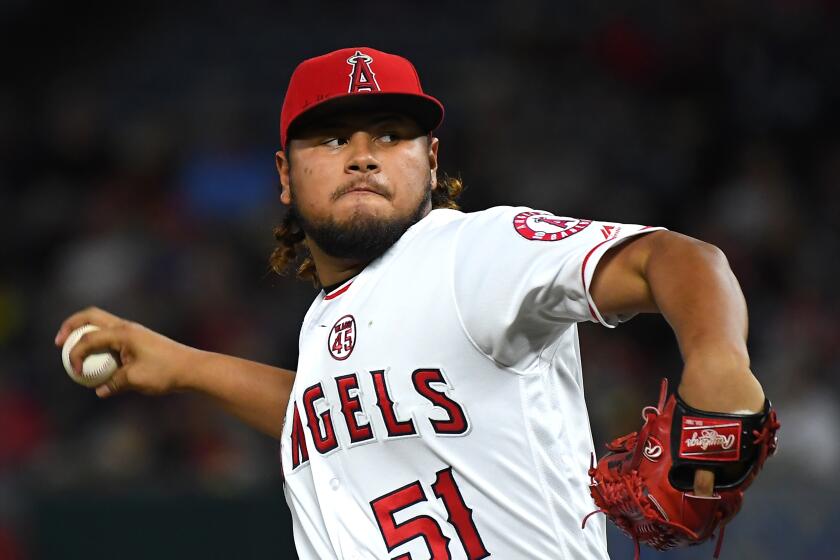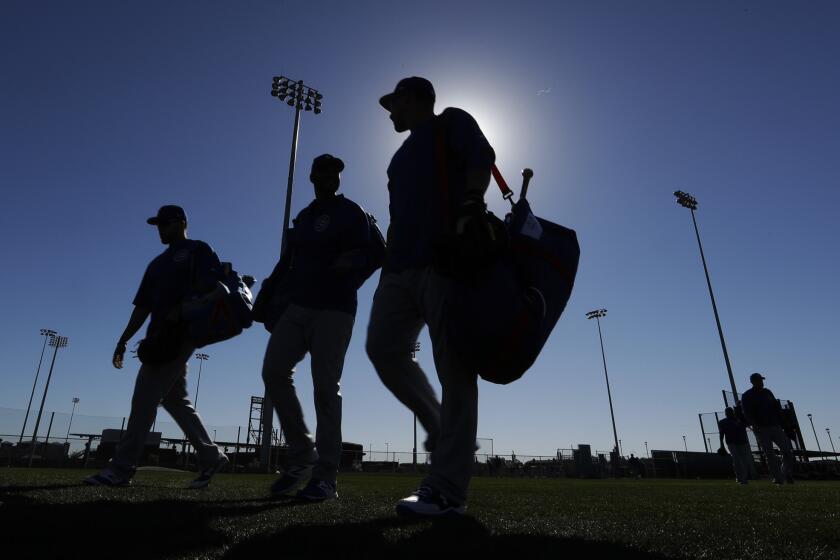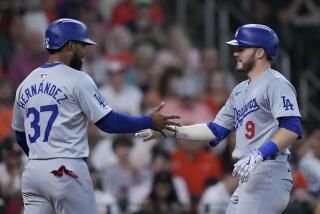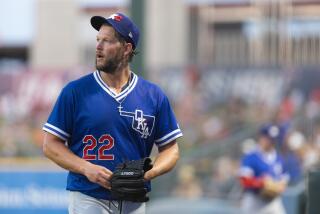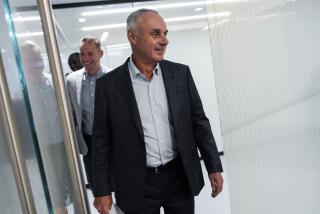MLB June amateur draft uncertain with college and high school baseball canceled
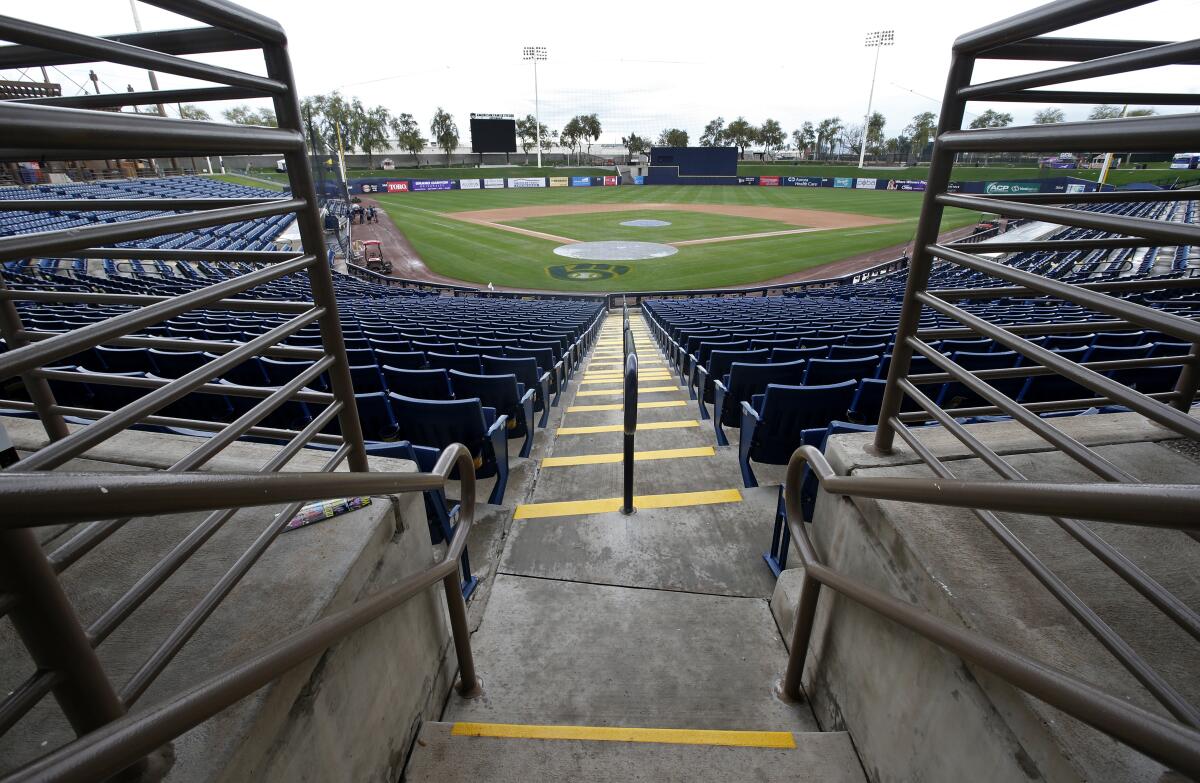
- Share via
For Billy Gasparino, it all happened so fast.
A week ago, the Dodgers’ director of amateur scouting began preparing his department for a slowdown and possible suspension of high school and college baseball games around the country in response to the COVID-19 pandemic, as governing bodies began implementing bans on large gatherings.
Two days later, Gasparino was in Texas on a scouting trip and planned to attend more games this weekend. By Thursday morning, those games were canceled. Hours later, he was home in Los Angeles, unsure when he’ll be back on the road to evaluate players for the upcoming 2020 draft — whenever it happens, if it happens.
Major League Baseball issued a directive Monday prohibiting all domestic and international scouting until further notice. The first-year player draft, commonly called the June draft, might not take place in June this year.
Also Monday, MLB acknowledged that the start of its season would be delayed for months, not weeks. The league offered no timetable but said it remains “committed to playing as many games as possible when the season begins.”
In accordance with guidelines from the Centers for Disease Control and Prevention, the earliest MLB could begin the season is mid-May, although that appears unlikely. At this point, any firm date is a guess.
With a rapidly growing number of college and high school baseball seasons around the country suspended or canceled, MLB scouting departments were left with little to scout in preparation for the annual influx of young talent.
With the Angels optioning Jaime Barria to triple A, there’s a four-way competition for the final two spots in the rotation.
On Sunday, Gasparino said the Dodgers had already planned to shut down scouting operations for two weeks starting Monday.
“We’re going to try to make it to April 1 and just reassess the environment,” Gasparino said. “Maybe creatively come up with some ideas, watch games on video. We have a lot of data we can sort through and just become more of a research department until we know what’s going to happen next.”
Angels scouting director Matt Swanson said the organization was still allowing personnel to scout games as of Sunday within driving distance of their homes “depending on where they are and if the situation allows for it.” That practice ended Monday. He personally waved a white flag Friday, after what he estimated was his fifth consecutive morning scrapping best-laid plans for scouting in his home state of Texas.
“There’s not much precedent for this,” Swanson said. “So I’ve tried to err on the side of caution with this. I’d rather be too cautious and allow ourselves to take a step back. This is kind of the wise thing to do, just pump the breaks a little bit.
This year’s draft is scheduled for June 10-12, but MLB, still sorting through the unprecedented circumstances, recently acknowledged in a memo to clubs that it will be different in some way, according to people who have seen the document.
How different, exactly, is the looming question.
A few club officials across the majors believe the 40-round draft will be cut short — perhaps to 30 rounds — and undoubtedly postponed.
“For me, personally, it makes sense to push the draft back until at least July,” a high-ranking executive with one major league club said.
Are you a true-blue fan?
Get our Dodgers Dugout newsletter for insights, news and much more.
You may occasionally receive promotional content from the Los Angeles Times.
Agent Scott Boras offered a more extreme suggestion: Hold two separate drafts this summer, one for college players and another for high school seniors.
Boras reasoned most elite Division 1 college players have been thoroughly scouted, from high school through college with summer leagues between those regular seasons, making this spring less important for their draft prospects. Their draft would be held first.
High school players, meanwhile, can drastically improve their stocks during their senior seasons, Boras said. The agent pointed to Royce Lewis and MacKenzie Gore as recent examples of high school seniors who improved their draft standing as high school seniors. The Minnesota Twins drafted Lewis, a shortstop, with the first overall pick in 2017. The San Diego Padres selected Gore, a left-handed pitcher, two picks later.
In his plan, the high school draft would be held later in the summer, perhaps in mid-July, after MLB staged a “competitive arena” for the country’s top high school players.
“The top Division I college players have been scouted for years,” Boras said. “There aren’t too many surprises. The high school players are most affected because you’re evaluating them on their junior and senior years.”
Boras’ method would stand to particularly benefit late bloomers and players from cold-weather areas, such as the Midwest and Northeast, where baseball seasons do not typically begin until mid-to-late March. Those players could be overlooked if they don’t play their senior campaigns.
“There’s always a guy that pops up in April or May and you gotta go see him,” said Cleveland Indians area scout Garrick Chaffee, who was asked by his club Friday to stay home in Texas until further notice. “There are college performers that have great statistical seasons that maybe the traditional scouting eye overlooks that you think to yourself, ‘All right, this guy’s had a really solid performing season. Maybe go back and get another look on him.’
“That’s absolutely something we’ll miss out on and something that you feel terrible for the players that don’t normally have those opportunities. Ultimately, those are the guys who suffer the most.”
One scout with nearly 30 years of experience, who requested anonymity because he wasn’t authorized to speak on the record, wondered if MLB would organize a draft at all.
He explained teams might not want a draft this summer because there would be a heightened probability of making mistakes on players they can’t scout deep into the spring. He added that every team has already evaluated players who would go in the top rounds of the draft, but in later rounds the risk of making a mistake increases.
“How do you give a guy $1 million and don’t know if he’s healthy?” he said.
If the June selection were to occur, Chaffee predicted that teams’ draft rooms would lack some of their usual vigor.
“I think we’ll still have conviction,” he said. “It just won’t be as much.”
Gasparino and Swanson said they’re confident their clubs would be ready if a draft were held tomorrow, but information gleaned from additional games — more hard data, more eye tests, bigger sample sizes — is always preferred in evaluating talent.
“We’re prepared,” Swanson said, “but it’s like you have to press hold right now and wait and see.”
A New York Yankees minor leaguer became the first pro baseball player to test positive for COVID-19, and MLB took steps to mitigate the virus’ spread.
In his ideal world, Gasparino said MLB would stage regional showcases or combine-like events while regulating the access teams have to players to curtail competitive advantage while ensuring players’ medical records are made available.
Yet implementing those measures would lead to other questions. When would the showcases be staged? How many would be necessary? Who would determine which players participate? What if a team is infatuated with a player as a sleeper and doesn’t want the secret out? Would there be enough time for even abbreviated short-season minor league schedules for the drafted players who sign?
For now, all Gasparino and his peers can do is wait for answers with their industry at a standstill.
Times staff writers Mike DiGiovanna and Dylan Hernández contributed to this report.
More to Read
Are you a true-blue fan?
Get our Dodgers Dugout newsletter for insights, news and much more.
You may occasionally receive promotional content from the Los Angeles Times.
